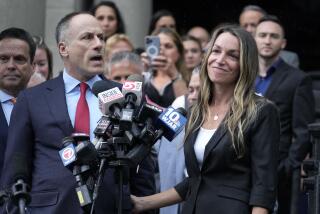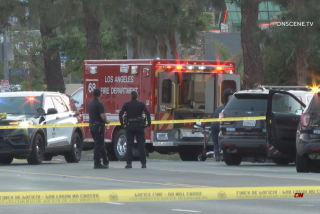Defense Demonstrates New Strategy in 2nd Tuffree Murder Trial
At first glance, the first and second murder trials of Daniel Allan Tuffree appear almost identical: same courtroom, same judge, same exhibits and many of the same witnesses.
But upon closer examination, subtle distinctions--and at least one radical strategy change--become evident.
In the past three months, defense attorneys have tried to pinpoint exactly what happened in the split seconds before their client, in his backyard, fatally shot a Simi Valley police officer Aug. 4, 1995.
Today they plan to call a key witness to back up a theory that delves into a new realm of possibilities about who shot whom and when.
âThere are some subtle distinctions in arguments being made,â said Deputy Public Defender Robert Willey, who joined the Tuffree defense team for the second trial.
âThe physical evidence is the same,â he said, but âthere are some major differences in how the evidence is coming in.â
One new spin on the case centers on glass fractures in the kitchen window where the deadly gunfight between Officer Michael Clark and Tuffree occurred.
Between the two trials, defense attorneys consulted with John Thornton, a fractures expert and a professor of criminalistics at UC Berkeley. Thornton is expected to take the witness stand this morning.
His testimony is expected to show that the glass fractures show a sequence of shots supporting a defense theory that Clark fired first.
Deputy Dist. Atty. Peter D. Kossoris said the fractures argument represents a slight departure from the theories laid out in the first trial, but he declined to comment further.
âI really wouldnât want to comment on issues that are in dispute that are obviously for the judge to resolve,â he said.
Prosecutors say Tuffree, 49, intentionally shot and killed Clark after the officer tried to persuade the distraught Van Nuys schoolteacher to come out of his house.
Defense attorneys say Tuffree shot in self-defense after being fired upon by Clark, one of three officers sent to Tuffreeâs home after reports that he was taking Valium, drinking alcohol and was possibly suicidal.
After a six-week trial, a jury deadlocked in October on whether the shooting was first-degree murder. Superior Court Judge Allan L. Steele was forced to declare a mistrial. The jury, however, did convict Tuffree of attempted murder for shooting at another officer.
Tuffree later waived his rights to a second jury trial in favor of a simpler court trial before the judge. The second trial started earlier this month and has continued off and on for the past few weeks.
In addition to expounding upon their theory about who fired first, defense attorneys have made a few other changes in trial strategy.
In his opening statement, for instance, Willey did not dispute that Clark was justified in firing at Tuffree when the officer saw that the man was armed. He asked the judge to rule in favor of a lesser charge of manslaughter.
âThe issue is not one of guilty or not guilty,â Willey said Wednesday. âIt is an issue of first-degree murder, second-degree murder, or voluntary or involuntary manslaughter.â
Also, defense attorneys have not disputed that Clark was acting in the capacity of a police officer when the gunfight started--a distinction from the first trial.
âCertainly, one obvious thing is, as I understand it, they have indicated that they are not disputing the special circumstances or the propriety of police conduct,â Kossoris said.
In the first trial, defense attorneys argued that police acted improperly and could have diffused the situation by leaving Tuffreeâs yard.
In his closing arguments Oct. 1, Deputy Public Defender Howard Asher said Tuffree was a troubled man whose right to be left alone in his home was ignored by authorities who pressed on toward a confrontation.
âThere was quite a bit of emphasis about things leading up to the police entry,â Kossoris said of the first trial. But in the second set of proceedings, he said, âthat hasnât appeared to be an issue.â
Because no jury has been present during the second trial, attorneys have not followed a strict court schedule. Defense and prosecution witnesses have been called intermittently and the tone has been more relaxed.
Prosecutors said they intend to call only a fraction of the 50 witnesses who testified at the first trial.
So far, seven witnesses--including police officers, ballistics experts and a county coroner--have testified. All but one of those individuals testified at the first trial.
At least four additional witnesses are expected to be called in the next three days, and attorneys on both sides expect the case to be wrapped up by next week.
More to Read
Sign up for Essential California
The most important California stories and recommendations in your inbox every morning.
You may occasionally receive promotional content from the Los Angeles Times.










